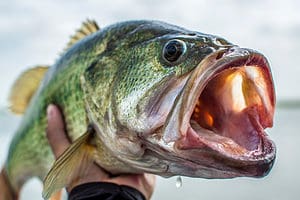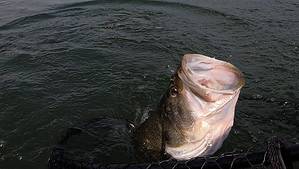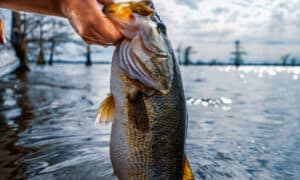Also known as the Beaver State to locals, Oregon seems to be a bit too chilly for warm-water fish like the majestic largemouth bass. However, during the warmer months of the year when waters hit around 60°F, Oregon’s anglers are able to compete to reel in their own whopper of bass in hopes of beating the current state record! But what is the largest largemouth bass ever caught in Oregon? Furthermore, how does it compare to the largest one in the world? Check it out below!
Incredible Facts About the Largemouth Bass
While most people know it simply as the largemouth bass, this unique fish’s scientific name is actually Micropterus salmoides. This means it’s part of the Micropterus genus, which consists of 13 different species. They’re commonly known as the black basses due to their dark brown markings that can look black underwater.
Notably, Micropterus includes species like the smallmouth and redeye basses, and all 13 are native to North America. They prefer warm, clear waters with lots of aquatic vegetation. However, all species, particularly the largemouth bass, are extremely hardy and can thrive in a wide range of freshwater habitats.
The first part of the largemouth’s scientific name, Micropterus, is Latin for “small fin.” This is actually a misnomer dating back to the 1800s! In 1802, French naturalist Count Lacépède examined and officially named the first black bass type specimen, a smallmouth. He noticed one of its dorsal fins had a tear down the center. This made the fish appear to have two very small fins instead of one larger one, hence the name.
Meanwhile, the second part of the largemouth’s scientific name, salmoides, simply translates to “salmon-like.” But while the largemouth is superficially similar in appearance to many types of salmon, the two fish are not very closely related. Collectively, the black basses are part of the freshwater sunfish family, Centrarchidae, so they’re more closely related to other freshwater species like the bluegill and crappie.
Out of all 13 black bass species, the largemouth is remarkable for several reasons. For starters, it’s by far the largest of the group, which we’ll cover in more detail below. Additionally, it’s the only true apex predator within the genus.
This is due to its large size, aggression, impressive swimming speed, and immense physical strength. Finally, it’s the most abundant and widespread of the black basses. It is now invasive in many other parts of the world. Today, its geographic range includes eastern Asia, southern Africa, the Iberian Peninsula in Europe, and even much of South America.
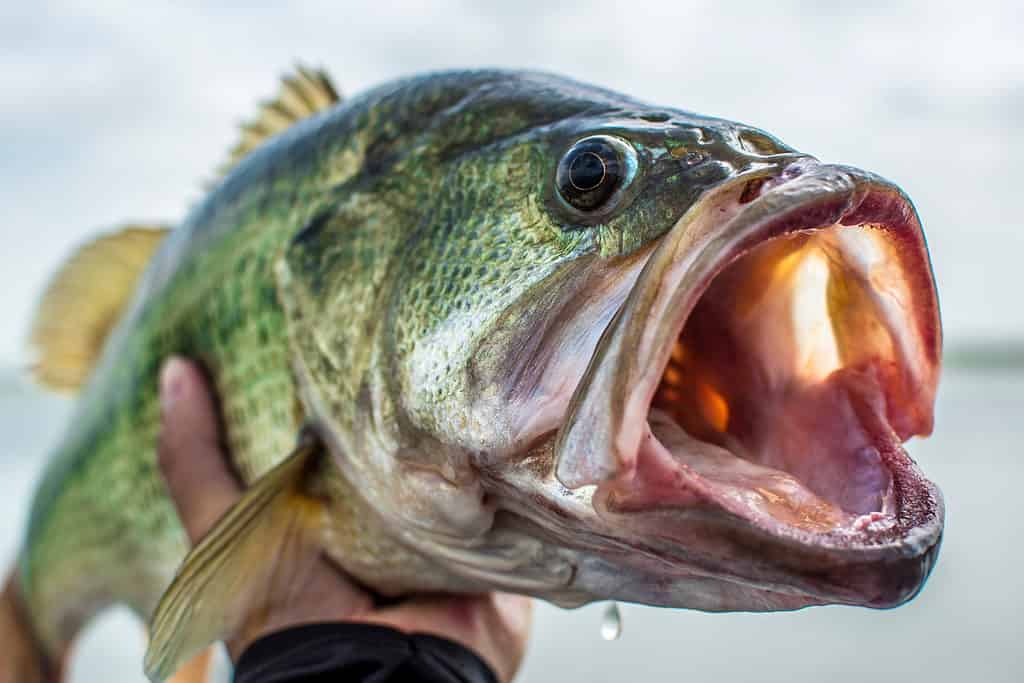
The largemouth bass is the only true apex predator within the genus. This is due to its large size, aggression, impressive speed, and immense physical strength.
©Pierre Rebollar/Shutterstock.com
How Big Do Largemouth Bass Get?
Like we just covered above, the largemouth is the largest member of the black bass. It’s also the largest member of its entire taxonomic family, Centrarchidae, which consists of 38 unique species!
Most black bass species, like the smallmouth and spotted basses, reach somewhere between 12 and 16 inches when fully grown. The largemouth, though, can grow to well over two feet in length! As juveniles, largemouth bass grow very quickly for their first two years of life. But they can continue growing well into their adulthood even long after they become sexually mature at 1 to 2 years old.
In terms of its weight, the largemouth is also an absolute beast of a fish. Generally, black basses tend to have lean, narrow bodies. The largemouth, however, can weigh anywhere from 5 to 15 pounds upon reaching adulthood. It also isn’t uncommon for especially large specimens to exceed 20 pounds.
Because largemouths display prominent sexual dimorphism, females are usually much larger and heavier than males. This is because their bodies must be large enough to accommodate more than 50,000 eggs at a time during the breeding season in the spring. As you might imagine, most record-breaking largemouth basses, such as the largest one ever caught in Oregon, are breeding females. Catch-and-release fishing is the norm within much of the specy’s native range to help sustain its numbers in the wild.
Although juvenile largemouths are commonly preyed upon by larger fish, birds, and reptiles, the largemouth has virtually no predators once fully grown. Thanks to its large size, powerful jaws equipped with razor-sharp teeth, and strong abdominal muscles, it can even eat prey around half the size of its own body. Its typical fare can include various smaller freshwater fish, aquatic invertebrates, and even other smaller largemouths!
What Is the Largest Largemouth Bass Ever Caught in Oregon?
Like most U.S. states, Oregon’s Department of Fish and Wildlife conveniently tracks state records for a wide range of common game fish. This, of course, includes the largemouth bass, as well as most other black bass species. Even though Oregon’s waters are often too cold for largemouth bass to be very active, it’s still possible to catch them during the spring and summer when water temperatures reach at least 60°F.
According to the Oregon Department of Fish and Wildlife’s current records, the largest largemouth bass ever caught in the Beaver State weighed 12 pounds, 1.6 ounces. Angler B. Adam Hastings caught it at Ballenger Pond. Hastings caught the fish in 2002. His catch exceeded the previous state record by roughly half a pound. Additionally, the specimen was 26.75 inches long and had a girth of roughly 22.25 inches.
Although Oregon’s Department of Fish and Wildlife doesn’t list an exact date for the catch, other local sources like the Oregon Bass and Panfish Club claim it occurred on July 6 of that year. Crucially, this is when largemouths and other black bass species are most active in the state, as water temperatures are highest in the late summer months. Hastings reportedly used a Senko worm, a type of soft plastic bait popular amongst bass anglers, to catch the fish.
Ballenger Pond, where Hastings caught the record-breaking bass, is located in Springfield, Oregon, near the state’s western coast. The pond is privately owned, so local anglers must get permission to fish there. Despite being modest in size and not a particularly well-known fishing spot, it gained an increase in popularity after Hastings’ impressive catch.
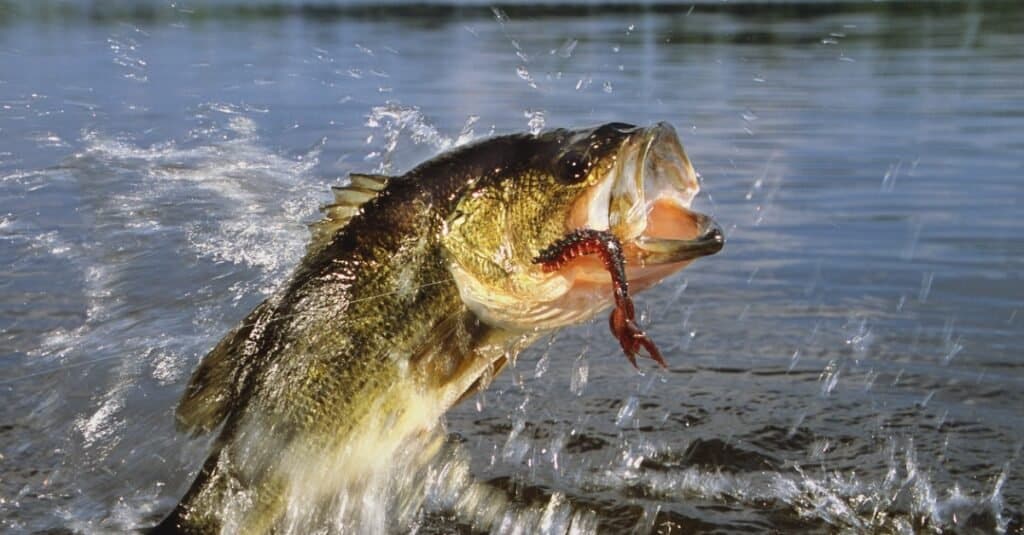
The largest largemouth bass ever caught in Oregon weighed 12 pounds, 1.6 ounces. Angler B. Adam Hastings caught it at Ballenger Pond in 2002.
©iStock.com/stammphoto
What is the Largest Largemouth Bass Ever Caught in the World?
Before we wrap things up, why don’t we compare the largest largemouth bass caught in Oregon to the current world record? Despite B. Adam Hastings’ brag-worthy bass weighing in at over 12 pounds, it’s still about 10 pounds lighter than the largest one ever caught in the world!
On July 2, 2009, Japanese angler Manabu Kurita reeled in a 22-pound, 4.97-ounce largemouth bass at Japan’s historic Lake Biwa. As one of Japan’s most ancient lakes, Lake Biwa is home to a thriving population of freshwater fish and water birds. It’s located in the Shiga Prefecture near Kyoto.
However, Kurita’s catch is only one half of the story. This is because he shares the world record with another skilled angler: George W. Perry of Rentz, Georgia. Importantly, the International Game Fishing Association dictates new record catches have to be more than 2 ounces larger than the previously established record. Perry’s bass, which he caught way back in 1932, weighed 22 pounds, 4 ounces. As a result, his and Kurita’s catches are technically in a tie for the official world record.
Perry caught his record-breaking bass on June 2, 1932, at Montgomery Lake, located in Telfair County, Georgia. Incredibly, he was only 19 years old at the time. Although Perry passed away in a plane crash in 1974, his legacy lives on. Manabu Kurita has managed to match his record, but no angler has been able to beat him yet officially. If you visit Montgomery Lake, you’ll even be able to spot a historical marker erected in honor of Perry’s catch!
Where is Lake Biwa Located on a Map?
Lake Biwa, located northeast of Kyoto in Shiga Prefecture, is a sizeable freshwater lake that is renowned for its abundant fish population, wetland areas, and migratory water birds. The lake’s surrounding area is home to beaches and resorts, such as Ōmi-Maiko.
Along the lake, visitors can find historic sites, including the 17th-century Hikone castle and the 8th-century Buddhist temple complex, Enryaku-ji. The Lake Biwa Museum offers exhibitions showcasing cultural and natural history.
Here is Lake Biwa on a map:
The photo featured at the top of this post is © Maclane Parker/Shutterstock.com
Thank you for reading! Have some feedback for us? Contact the AZ Animals editorial team.



